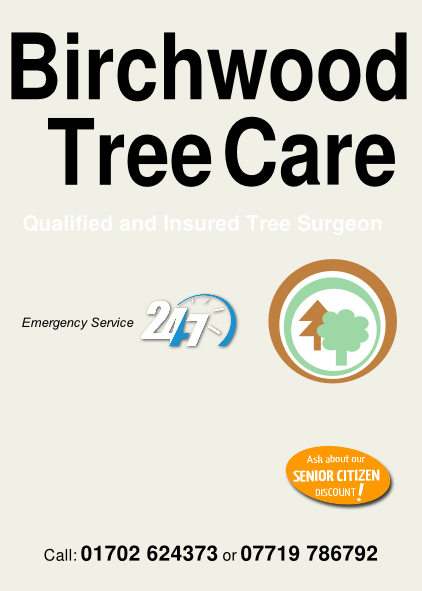
birchwoodtreecare.co.uk -
Website Terms | Privacy Statement
designed by UKWebb.com
- What should I do if tree roots cause cracks in my driveway or drains and does it mean that my house will be damaged next?
- Can I get my neighbour to cut back or reduce the height of their trees or hedge?
- Should Ivy be removed from trees?
- Will hammering a nail into a tree kill or harm the tree?
- I have a tree which is outside my boundary and not under my control -
whose responsibility is it? - I am worried that my neighbour’s tree is dangerous. What should I do?
- Branches or roots from my neighbour’s tree are growing over my boundary. What can I do?

Questions?
My neighbours are unhappy that a tree growing in my garden overhangs their property and say that they have the right to cut it back. Is this correct?
Under common law rights a neighbour can cut back any foliage that overhangs the boundary to the boundary line without reference to the owner of the tree/shrub (this includes roots!). If the tree is covered by a Tree Preservation Order or is growing within a Conservation Area, the consent of the local planning authority must first be obtained. There is no right for anyone to enter the tree owner's land to carry out these works.
How can I find out if the trees within my ownership are protected?
You can check to see if a property or area of land has a Tree Preservation Order on it, or if it is located within a Conservation Area, by looking at the council website or by contacting the local council (usually the planning department). If your tree is protected then you will need to apply to the Council to carry out any work.
Can I stop my neighbour building close to my tree?
You may be able to depending on the importance of the tree, the nature of the building proposed and distance between the proposed building and the tree in question.
If the building work proposed requires planning consent, all trees which could potentially be affected by the development (including those on adjoining property) should be assessed by an arboricultural consultant in accordance with British Standard BS5837:2012 Trees in relation to design, demolition and construction – Recommendations, and details of this assessment submitted with the planning application. The Local Planning Authority should consider how the proposed development will affect trees in accordance with the same document and, if the process works correctly, this should prevent unacceptable damage from occurring to your tree. If you are concerned, you should instruct an arboricultural consultant to assist and if necessary, make a formal objection to the planning application within the statutory timeframe.
If the work proposed does not require planning consent, it may be less easy for you to influence. If your tree is protected by a Tree Preservation Order (TPO) or is located within a conservation area, legislation relating to tree protection overrides that of permitted development rights, and developers will risk prosecution if protected trees are damaged. If you consider that your tree provides sufficient public amenity value to warrant protection by a TPO, you can make a formal request to the Local Planning Authority to place a TPO on your tree. An arboricultural consultant can advise you on these matters.
What should I do if tree roots cause cracks in my driveway or drains and does it mean that my house will be damaged next?
Tree roots typically grow close to the surface, and it is not uncommon for them to develop on the underside of hard surfaces such as driveways, which can lead to cracks developing through physical pressure. This damage is frequently superficial, and there is a range of options available which include: do nothing; repair the cracks; remove the existing surface and replace with a new one engineered to accommodate the roots; prune the roots or remove the tree (the latter two subject to Tree Preservation Order consent or conservation area notification if relevant).
Tree roots can cause problems by blocking drains. They do not usually cause the initial damage to the drain and will only enter drains which are already damaged and leaking. Therefore, if drains are watertight, roots should not normally affect them. If your drains are blocked by roots you will need a drainage company to assist. It is possible that the drains will require lining or replacing. Removing the tree seldom resolves the problem as the drain remains damaged and can leak (possibly causing foundation damage) or may be infiltrated by the roots of other plants unless the drain is repaired.
If your driveway or drains have been affected by roots, this does not necessarily mean that your house will be damaged next. Root damage to buildings is much rarer and is usually caused by subsidence: an entirely different mechanism to driveways and drains damage.
Can I get my neighbour to cut back or reduce the height of their trees or hedge?
In most situations the simple answer to this is no. You have a common law right to prune back parts of a tree or hedge growing over the boundary into your property (subject to any legal restrictions being overcome first such as Tree Preservation Orders or conservation areas) but you cannot compel the owner of the trees or hedge to carry out this work or pay for it. As a general rule you have no legal right to a view which has been obscured by your neighbour’s trees.
If your neighbour owns an evergreen hedge close to your property you can make a formal complaint to your Local Planning Authority (LPA) under the High Hedges legislation as set out in Part 8 of the Antisocial Behaviour Act 2003. There is usually a charge for this process. The LPA will consider the complaint using standard government guidance set out in a document called Hedge Height and Light Loss. If your complaint is successful the LPA will determine an Action Height to which the height of the hedge must be reduced.
If your neighbour’s tree or hedge is dangerous and is a hazard to your property then there is action that can usually be taken. In this situation you should contact an arboricultural consultant for further advice.
It is always better to settle a dispute about trees amicably and it is recommended that you try to resolve it by talking to your neighbours first.
Should Ivy be removed from trees?
For many years, gardeners and arborists alike would, as a matter of common tree maintenance, clear ivy from trees in order to remove the competition for light, water and nutrients, as well as the potential threat of the ivy totally smothering the tree. However, in the light of increasing knowledge and research into the relationship between the plant and its host, it is now not considered an instant threat to the tree, and it is not necessary to remove it on a regular basis.
In certain circumstances (tree inspection, formal areas etc.) it is necessary to clear trees of ivy in order to carry out a detailed inspection of the condition of the tree, or to keep the appearance of the tree ‘tidy’. However, in many instances where trees are in a less strictly managed area, especially where wildlife conservation is the main aim, ivy does not need to be removed.
Ivy is an attractive habitat for insects and invertebrates and consequently bird and animal life can benefit as a result of an increase in available food source. Bats, which are rare and protected by law regularly roost amongst ivy, as well as inside small cavities in suitable trees.
It would therefore depend on the main aims of the managers of the land in question as to whether the ivy is removed from the trees or it is left to provide a wildlife benefit.
Will hammering a nail into a tree kill or harm the tree?
Hammering anything into a tree is intrusive and will cause harm; a tree is a living organism and an injury such as this is damaging. The outer bark layer on a tree stem protects against disease and decay, anything that breaches it can allow the entry of harmful organisms. The significance of any harm will depend on a number of factors such as the extent of the injury, the species and age of the tree and its overall condition. For example, a single nail is unlikely to cause great harm to an established tree that has natural durability such as oak or sweet chestnut but it could be more harmful to a tree with lower durability such as birch or poplar.
I have a tree which is outside my boundary and not under my control -
The law is very clear with regard to a tree owner’s ‘duty of care’: Legally, the owner of the land is responsible for trees growing on their land.
If the tree is growing on Council owned or managed land then you should contact your local Council.
I am worried that my neighbour’s tree is dangerous. What should I do?
If a tree growing on someone else’s land causes injury to someone or damage to property then the owner may be liable. If you think your neighbour’s tree might be dangerous then you should contact an arboricultural consultant for further advice. It is always best to settle a dispute about trees amicably and it is recommended that you try to resolve the matter by talking to your neighbours first. If the tree is identified as an immediate danger, and your neighbour has refused to address the problem, then the Council may intervene if formally requested to do so.
Branches or roots from my neighbour’s tree are growing over my boundary. What can I do?
Under ‘common law’, you may be able to prune branches and roots which grow over your boundary. However, you also have a legal duty to take ‘reasonable care’ whilst undertaking any works and you may be liable if you damage the tree or cause it to become unstable. It is therefore unwise to undertake works without first consulting a qualified arboriculturist (tree expert), ideally approved by the Arboricultural Association. You should also check with the Council prior to undertaking any works to make sure that the trees are not protected.
Information courtesy of The Arboricultural Association
To ask any more questions, please visit their website, click HERE



















| Crown |
| Tips & Advice |